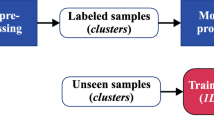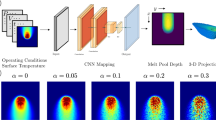Abstract
The intricate non-equilibrium and rapid solidification behavior inherent in laser powder bed fusion (LPBF) additive manufacturing affects the quality and performance of as-built parts. To evaluate and predict the quality of LPBF-built parts, engaging in real-time monitoring of the LPBF process by leveraging thermal information derived from the melt pool becomes significant. In this work, the insights conveyed by near-infrared (NIR) thermal-imaging on melt pools during the LPBF process were explored, with the assistance of machine learning (ML) and deep learning (DL) methods, aiming to develop ML and DL models capable of recognizing NIR melt-pool monitoring images and predicting invisible geometries of laser-tracks. Traditional ML models, including support vector machines, were used to establish a non-linear mapping relationship between NIR thermal images and cross-sectional geometries of solidified laser-tracks. That was achieved by extracting melt-pool NIR image features based on prior knowledge while analyzing the influence of laser parameters on the melt pools. Then, DL models such as convolutional neural networks were improved to extract multi-scale features from the melt-pool thermal images through self-learning mechanisms. By comprehensively merging multi-scale features, these DL models effectively captured and reflected vital NIR image information from the melt pool. The various methodologies collectively provided real-time insights for monitoring and controlling the LPBF processes, thereby facilitating reasoning about and predicting imperceptible geometries of the cross-sectional solidified laser-tracks within the as-built parts.























Similar content being viewed by others
Data availability
Data will be made available on request.
References
Alabort, E., Tang, Y. T., Barba, D., & Reed, R. C. (2022). Alloys-by-design: A low-modulus titanium alloy for additively manufactured biomedical implants. Acta Materialia, 229, 117749.
Aminzadeh, M., & Kurfess, T. R. (2019). Online quality inspection using Bayesian classification in powder-bed additive manufacturing from high-resolution visual camera images. Journal of Intelligent Manufacturing, 30, 2505–2523.
Ashby, A., Guss, G., Ganeriwala, R. K., Martin, A. A., DePond, P. J., Deane, D. J., Matthews, M. J., & Druzgalski, C. L. (2022). Thermal history and high-speed optical imaging of overhang structures during laser powder bed fusion: A computational and experimental analysis. Additive Manufacturing, 53, 102669.
Blakey-Milner, B., Gradl, P., Snedden, G., Brooks, M., Pitot, J., Lopez, E., Leary, M., Berto, F., & du Plessis, A. (2021). Metal additive manufacturing in aerospace: A review. Materials & Design, 209, 110008.
Cai, Y. H., Xiong, J., Chen, H., & Zhang, G. J. (2023). A review of in-situ monitoring and process control system in metal-based laser additive manufacturing. Journal of Manufacturing Systems, 70, 309–326.
Demir, A. G., Kim, J., Caltanissetta, F., Hart, A. J., Tasan, C. C., Previtali, B., & Colosimo, B. M. (2022). Enabling multi-material gradient structure in laser powder bed fusion. Journal of Materials Processing Technology, 301, 117439.
Estalaki, S. M., Lough, C. S., Landers, R. G., Kinzel, E. C., & Luo, T. (2022). Predicting defects in laser powder bed fusion using in-situ thermal imaging data and machine learning. Additive Manufacturing, 58, 103008.
Fonseca, E. B., Escobar, J. D., Gabriel, A. H. G., Ribamar, G. G., Boll, T., & Lopes, É. S. N. (2022). Tempering of an additively manufactured microsegregated hot-work tool steel: A high-temperature synchrotron X-ray diffraction study. Additive Manufacturing, 55, 102812.
Gaikwad, A., Chang, T., Giera, B., Watkins, N., Mukherjee, S., Pascall, A., Stobbe, D., & Rao, P. (2022). In-process monitoring and prediction of droplet quality in droplet-on-demand liquid metal jetting additive manufacturing using machine learning. Journal of Intelligent Manufacturing, 33(7), 2093–2117.
He, K., Zhang, X., Ren, S., & Sun, J. (2016). Deep Residual Learning for Image Recognition. IEEE Conference on Computer Vision and Pattern Recognition (CVPR), 2016, 770–778.
Hertlein, N., Deshpande, S., Venugopal, V., Kumar, M., & Anand, S. (2022). Prediction of selective laser melting part quality using hybrid Bayesian network. Additive Manufacturing, 32, 101089.
Huang, G., Liu, Z., Laurens, V., & Weinberger, K. Q. (2017). Densely connected convolutional networks. IEEE Conference on Computer Vision and Pattern Recognition (CVPR), 2017, 2261–2269.
Jensen, S. C., Koepke, J. R., Saiz, D. J., Heiden, M. J., Carroll, J. D., Boyce, B. L., & Jared, B. H. (2022). Optimization of stochastic feature properties in laser powder bed fusion. Additive Manufacturing, 56, 102943.
Kim, J., Yang, Z., Ko, H., Cho, H., & Lu, Y. (2023). Deep learning-based data registration of melt-pool-monitoring images for laser powder bed fusion additive manufacturing. Journal of Manufacturing Systems, 68, 117–129.
Lapointe, S., Guss, G., Reese, Z., Strantza, M., Matthews, M. J., & Druzgalski, C. L. (2022). Photodiode-based machine learning for optimization of laser powder bed fusion parameters in complex geometries. Additive Manufacturing, 53, 102687.
Li, C., Sun, J., & Palade, V. (2021). MSLDOCK: Multi-swarm optimization for flexible ligand docking and virtual screening. Journal of Chemical Information and Modeling, 61, 1500–1515.
Li, J., Zhou, Q., Cao, L., Wang, Y., & Hu, J. (2022). A convolutional neural network-based multi-sensor fusion approach for in-situ quality monitoring of selective laser melting. Journal of Manufacturing Systems, 64, 429–442.
Li, M., Li, Y., Wu, N., Tian, Y., & Wang, T. (2020a). Desert seismic random noise reduction framework based on improved PSO-SVM. Acta Geodaetica Et Geophysica, 55, 101–117.
Li, X., Jia, X., Yang, Q., & Lee, J. (2020b). Quality analysis in metal additive manufacturing with deep learning. Journal of Intelligent Manufacturing, 31, 2003–2017.
Lough, C. S., Liu, T., Wang, X., Brown, B., Landers, R. G., Bristow, D. A., Drallmeier, J. A., & Kinzel, E. C. (2022). Local prediction of laser powder bed fusion porosity by short-wave infrared imaging thermal feature porosity probability maps. Journal of Materials Processing Technology, 302, 117473.
Mahmoud, D., Magolon, M., Boer, J., Elbestawi, M. A., & Mohammadi, M. G. (2021). Applications of machine learning in process monitoring and controls of L-PBF additive manufacturing: A review. Applied Sciences, 11, 11910.
McGregor, D. J., Bimrose, M. V., Tawfick, S., & King, W. P. (2022). Large batch metrology on internal features of additively manufactured parts using X-ray computed tomography. Journal of Materials Processing Technology, 306, 117605.
Mi, J., Zhang, Y., Li, H., Shen, S., Yang, Y., Song, C., Zhou, X., Duan, Y., Lu, J., & Mai, H. (2023). In-situ monitoring laser based directed energy deposition process with deep convolutional neural network. Journal of Intelligent Manufacturing, 34, 683–693.
Paulson, N. H., Gould, B., Wolff, S. J., Stan, M., & Greco, A. C. (2020). Correlations between thermal history and keyhole porosity in laser powder bed fusion. Additive Manufacturing, 34, 101213.
Peng, X., Wu, S., Qian, W., Bao, J., Hu, Y., Zhan, Z., Guo, G., & Withers, P. J. (2022). The potency of defects on fatigue of additively manufactured metals. International Journal of Mechanical Sciences, 221, 107185.
Promoppatum, P., Srinivasan, R., Quek, S. S., Msolli, S., Shukla, S., Johan, N. S., van der Veen, S., & Jhon, M. H. (2022). Quantification and prediction of lack-of-fusion porosity in the high porosity regime during laser powder bed fusion of Ti-6Al-4V. Journal of Materials Processing Technology, 300, 117426.
Qi, X., Chen, G., Li, Y., Cheng, X., & Li, C. (2019). Applying neural-network-based machine learning to additive manufacturing: Current applications, challenges, and future perspectives. Engineering, 5, 721–729.
Qu, M., Guo, Q., Escano, L. I., Nabaa, A., Hojjatzadeh, S. M. H., Young, Z. A., & Chen, L. (2022). Controlling process instability for defect lean metal additive manufacturing. Nature Communications, 13, 1–8.
Ramalho, A., Santos, T. G., Bevans, B., Smoqi, Z., Rao, P., & Oliveira, J. P. (2022). Effect of contaminations on the acoustic emissions during wire and arc additive manufacturing of 316L stainless steel. Additive Manufacturing, 51, 102585.
Salifu, S., Desai, D., Ogunbiyi, O., & Mwale, K. (2022). Recent development in the additive manufacturing of polymer-based composites for automotive structures—a review. The International Journal of Advanced Manufacturing Technology, 119, 6877–6891.
Scime, L., & Beuth, J. (2019). Melt pool geometry and morphology variability for the Inconel 718 alloy in a laser powder bed fusion additive manufacturing process. Additive Manufacturing, 29, 100830.
Tempelman, J. R., Wachtor, A. J., Flynn, E. B., Depond, P. J., Forien, J.-B., Guss, G. M., Calta, N. P., & Matthews, M. J. (2022). Sensor fusion of pyrometry and acoustic measurements for localized keyhole pore identification in laser powder bed fusion. Journal of Materials Processing Technology, 308, 117656.
Wallace, N. J., Crane, N. B., & Jones, M. R. (2022). Defect measurement limits using flash thermography with application to additive manufacturing. NDT & E International, 128, 102615.
Wang, B., Dong, L., Zhao, M., & Xu, W. (2017). Fast infrared maritime target detection: Binarization via histogram curve transformation. Infrared Physics & Technology, 83, 32–44.
Wang, H., Li, B., & Xuan, F. (2022a). Acoustic emission for in situ process monitoring of selective laser melting additive manufacturing based on machine learning and improved variational modal decomposition. The International Journal of Advanced Manufacturing Technology, 122, 2277–2292.
Wang, H., Li, B., & Xuan, F. (2022b). A dimensionally augmented and physics-informed machine learning for quality prediction of additively manufactured high-entropy alloy. Journal of Materials Processing Technology, 307, 117637.
Wang, H., Li, B., & Xuan, F. (2022c). Fatigue-life prediction of additively manufactured metals by continuous damage mechanics (CDM)-informed machine learning with sensitive features. International Journal of Fatigue, 164, 107147.
Williams, R. J., Piglione, A., Rønneberg, T., Jones, C., Pham, M.-S., Davies, C. M., & Hooper, P. A. (2019). In situ thermography for laser powder bed fusion: Effects of layer temperature on porosity, microstructure and mechanical properties. Additive Manufacturing, 30, 100880.
Yang, H., Wang, W., Li, C., Qi, J., Wang, P., Lei, H., & Fang, D. (2022). Deep learning-based X-ray computed tomography image reconstruction and prediction of compression behavior of 3D printed lattice structures. Additive Manufacturing, 54, 102774.
Zheng, L., Zhang, Q., Cao, H., Wu, W., Ma, H., Ding, X., Yang, J., Duan, X., & Fan, S. (2019). Melt pool boundary extraction and its width prediction from infrared images in selective laser melting. Materials & Design, 183, 108110.
Zheng, Q., Chen, G., & Jiao, A. (2022). Chatter detection in milling process based on the combination of wavelet packet transform and PSO-SVM. The International Journal of Advanced Manufacturing Technology, 120, 1237–1251.
Acknowledgements
This research work is sponsored by National Natural Science Foundation of China (Grant No. 52175140), National Key R&D Program of China (Grant No. 2022YFB4602102), Pre-research project of Civil Aerospace Technology (Grant No. D020301), Equipment Pre-research Sharing Technology Key Project (Grant No. JZX7Y20210422004601), and Fundamental Research Funds for the Central Universities in China (Grant No. JKG01231610).
Author information
Authors and Affiliations
Contributions
HW: Writing-original draft, Investigation, Methodology, Visualization. BL: Conceptualization, Investigation, Formal analysis, Writing-original draft, Writing-review & editing, Validation, Funding acquisition. SZ: Data curation, Investigation, Methodology, Visualization. FX: Validation, Supervision, Resources, Project administration.
Corresponding author
Ethics declarations
Conflict of interest
The authors have no known competing financial interests or personal relationships that could have appeared to influence the work reported in this work. All authors have read and agreed to the published version of the manuscript.
Additional information
Publisher's Note
Springer Nature remains neutral with regard to jurisdictional claims in published maps and institutional affiliations.
Supplementary Information
Below is the link to the electronic supplementary material.
Rights and permissions
Springer Nature or its licensor (e.g. a society or other partner) holds exclusive rights to this article under a publishing agreement with the author(s) or other rightsholder(s); author self-archiving of the accepted manuscript version of this article is solely governed by the terms of such publishing agreement and applicable law.
About this article
Cite this article
Wang, H., Li, B., Zhang, S. et al. Traditional machine learning and deep learning for predicting melt-pool cross-sectional morphology of laser powder bed fusion additive manufacturing with thermographic monitoring. J Intell Manuf (2024). https://doi.org/10.1007/s10845-024-02356-9
Received:
Accepted:
Published:
DOI: https://doi.org/10.1007/s10845-024-02356-9




